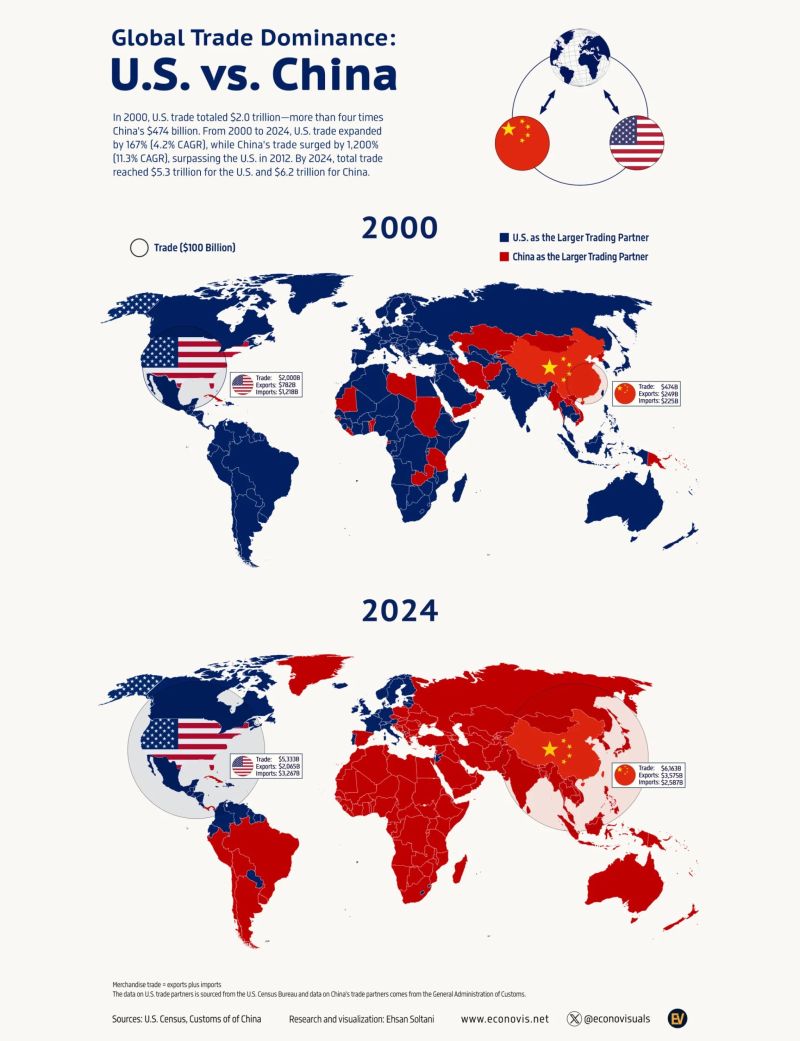-
AutorPublicaciones
-
-
The Changing
Landscape of Global
Trade: A
Comparative
Analysis of U.S.
and China’s Trade
Dominance (2000-
2024) and Africa’s
Emerging Role.

Abstract:
The dynamics of global trade have evolved dramatically from the year 2000 to 2024. At the turn of the millennium, the United States was the uncontested leader in global trade, surpassing China by a wide margin. However, over the next two decades, China has seen a remarkable surge in trade, surpassing the U.S. in 2012 and becoming the dominant trading partner in several regions worldwide. This article examines the trade growth trajectories of the U.S. and China, the shifting patterns of global trade dominance, and the implications for emerging markets, particularly Africa, in the context of ongoing initiatives like the African Continental Free Trade Area (AfCFTA). The article explores how Africa’s role in global trade is poised to evolve, with particular emphasis on the region’s trade relationship with China and the potential for intra-African trade.
Introduction.
Global trade patterns in 2024 are vastly different from those of 2000, reflecting shifts in economic power and changing trade dynamics. At the turn of the century, the United States had a dominant position in global trade, with total trade valued at $2.0 trillion, more than four times the size of China’s trade, which was only $474 billion. China’s role in the global economy was still limited to a handful of countries, mostly in the developing world. Fast forward to 2024, and China has firmly established itself as the leading trade partner for numerous regions, surpassing the U.S. in trade volume by 2012. This shift highlights China’s rise as a global economic powerhouse, fundamentally altering the trade landscape and reshaping international economic relations.
Trade Growth and Dominance: U.S. vs. China (2000-2024).
The growth trajectories of U.S. and Chinese trade between 2000 and 2024 offer stark contrasts. U.S. trade grew by 167%, with a compound annual growth rate (CAGR) of 4.2%, reaching $5.3 trillion by 2024. In contrast, China’s trade skyrocketed by 1,200%, with an astonishing CAGR of 11.3%, surpassing $6.2 trillion by 2024. This exceptional growth in China’s trade can be attributed to multiple factors, including its aggressive export strategies, strategic partnerships, and its integration into global supply chains.
By 2012, China overtook the U.S. to become the world’s largest trading nation, a position it has held ever since. As a result, China’s influence has expanded, particularly in Asia, Eastern Europe, the Middle East, Oceania, South America, and Africa. China’s dominance in global trade has been further fueled by its ability to integrate emerging markets into its trade network, exporting manufactured goods while importing raw materials, including fuels, minerals, and agricultural products.
Regional Shifts in Global Trade.
China’s trade expansion has not only allowed it to surpass the U.S. in total trade volume but also to become the dominant trade partner for many regions across the globe. In Asia, China has become the central hub for trade, with countries like Japan, South Korea, and Southeast Asian nations heavily reliant on Chinese imports and exports. Similarly, Eastern Europe and the Middle East have seen increasing trade flows with China, which is now a significant player in their economic landscapes.
China’s trade relationships with Africa have also deepened over the past two decades. The continent, which was largely on the periphery of global trade in 2000, has seen an influx of Chinese investment, particularly in infrastructure, natural resources, and energy sectors. As China continues to import raw materials from Africa, such as oil, minerals, and agricultural goods, the trade relationship has become increasingly symbiotic.
Despite these shifts, the United States remains a critical trading partner for many regions. In 2024, North America, Europe (excluding Russia), North Africa, and India are expected to strengthen their economic ties with the U.S., as the American market continues to offer a robust consumer base and advanced technology. The U.S. trade agenda, focusing on high-tech exports and services, remains a cornerstone of its global trade position.
The Role of Africa in the New Global Trade Order.
In the context of the evolving global trade order, Africa’s role is becoming increasingly pivotal. The African continent, historically underrepresented in global trade, is on the verge of a transformative shift. Africa’s trade with China has been one of the most notable changes in the last two decades, and the continent’s economic future is closely linked to China’s continued engagement. However, the AfCFTA is poised to reshape Africa’s internal trade dynamics, making intra-African trade a more significant component of the continent’s economic growth.
The African Continental Free Trade Area (AfCFTA), launched in 2021, is one of the most ambitious trade agreements in Africa’s history. Designed to create a single continental market, AfCFTA aims to eliminate tariffs, reduce trade barriers, and foster economic integration among African nations. The goal is to increase intra-African trade, which has historically been low compared to other regions, and to position Africa as a major player in the global trade network.
Implications for Africa’s Future in Global Trade.
As the global trade landscape continues to evolve, Africa’s economic potential is increasingly recognized. The continent’s vast natural resources, growing population, and rising middle class present significant opportunities for economic growth. Africa’s role as a supplier of raw materials, including minerals, oil, and agricultural products, will continue to be important, especially as demand from China and other emerging markets remains strong.
In addition, Africa’s emerging digital economy, driven by advancements in technology, infrastructure development, and the rise of small and medium-sized enterprises (SMEs), is expected to enhance the region’s participation in global trade. Initiatives like the African Union’s Agenda 2063, which outlines a vision for a united, prosperous, and integrated Africa, provide a framework for fostering trade and investment across the continent.
Furthermore, the shift towards a more interconnected global economy means that Africa is not only a recipient of foreign investment but also an emerging source of investment, particularly in the areas of infrastructure, technology, and manufacturing. The continued development of transport corridors, such as the Trans-African Highway, and the expansion of digital trade platforms will facilitate greater economic integration within the continent.
Conclusion.
The global trade environment in 2024 is markedly different from 2000, with China’s meteoric rise to the top of global trade reshaping the world’s economic order. While the U.S. remains a significant player in global trade, China’s dominance, particularly in regions like Asia, Africa, and Latin America, is undeniable. Looking forward, Africa’s role in the global trade system is poised for growth, with the AfCFTA playing a crucial role in unlocking the continent’s potential. As Africa continues to engage with China, the U.S., and other emerging markets, it stands on the precipice of a new era of economic integration and prosperity.
In this evolving trade landscape, Africa’s future is bright, and the continent’s growing influence in the global economy is a testament to the transformative power of strategic trade partnerships and regional cooperation.
Keywords: Global Trade, U.S. vs China, Trade Dominance, Africa, AfCFTA, Emerging Markets, Economic Growth, Intra-African Trade, China-Africa Relations, U.S. Trade Policy, Agenda 2063, African Integration.
-
-
AutorPublicaciones
Debes iniciar sesión para responder a este tema.









